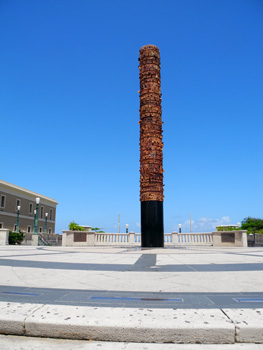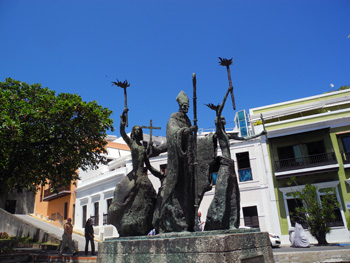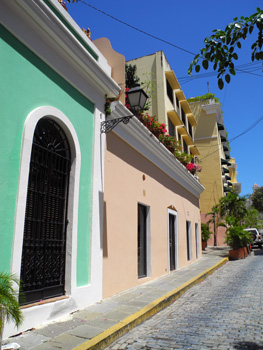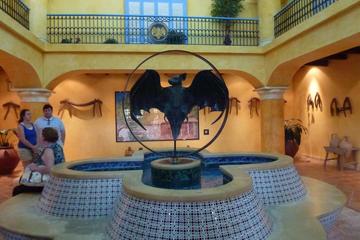 by Susmita Sengupta
by Susmita Sengupta
 Mofongo. The name resonated with me, lyrical, pleasing, delightful and most importantly appetizing. I had arrived in San Juan, Puerto Rico for a spring break vacation accompanied by my husband and daughter. I had never heard of such a dish and I was eager to try it. The mofongo arrived accompanied by succulent shrimp bathed in a turmeric sauce laced with onions, tomatoes, bayleaf and spices. It was delicious. This was my introduction to the classic dish made of fried plantains that is pulverized in a mortar and pestle and mixed with garlicky olive oil and fried pork rinds and bacon. It is a dish that reflects the history and culture of this island.
Mofongo. The name resonated with me, lyrical, pleasing, delightful and most importantly appetizing. I had arrived in San Juan, Puerto Rico for a spring break vacation accompanied by my husband and daughter. I had never heard of such a dish and I was eager to try it. The mofongo arrived accompanied by succulent shrimp bathed in a turmeric sauce laced with onions, tomatoes, bayleaf and spices. It was delicious. This was my introduction to the classic dish made of fried plantains that is pulverized in a mortar and pestle and mixed with garlicky olive oil and fried pork rinds and bacon. It is a dish that reflects the history and culture of this island.
Puerto Rico, an island in the Caribbean, is the smallest island of the Greater Antilles. It was originally inhabited by Taino Indians when the Spanish arrived in the 15th century. The island was discovered on November 19th, 1493 by Christopher Columbus on his second voyage to the New World. He named the island San Juan de Bautista in honor of St. John the Baptist and the town Puerto Rico meaning rich port. In 1508, Juan Ponce de Leon was appointed the first governor of the island by the Spanish government. In the 1520s the island and town names got interchanged and the entire island was called Puerto Rico. San Juan became famous as an important port for merchant and military ships traveling to and from Europe. After the Spanish American war in 1898, Spain ceded Puerto Rico to the United States under the terms of the Treaty of Paris. Since then, Puerto Rico has been a territory of the United States and San Juan has been its capital.
After the traditional Puerto Rican meal and a night’s rest, we decided to start our sightseeing by first visiting Old San Juan, also called Viejo San Juan and its primary attraction, EL Morro fort.
 Castillo San Felipe del Morro, commonly known as El Morro, is a 16th century, six level fortress. It was named in honor of Spain’s King Philip II. The fort went through several phases of construction beginning in 1539 when the Spanish felt a fort was needed to protect San Juan from attacks by pirates and privateers. In its first phase of construction between 1539-1540, it was a small structure at the entrance to San Juan harbor. Sir Francis Drake from England attacked the island in 1595 but the Spanish were able to defeat him. But in 1598, Sir George Clifford, the Earl of Cumberland, attacked El Morro and conquered the city. Although he could only hold the city for a very short period of time, it prompted the Spanish to improve the fortification of little El Morro. There was a flurry of construction beginning in the 1600s with the building of the walls that surrounded the city. The enlargement of El Morro started in 1765 and the entire process that began in 1539 took about 150 years to complete. Today, El Morro and its companion fort, Castillo San Cristobal which was built to protect El Morro from land attacks, are part of the US National Park Service and a UN designated World Heritage Site.
Castillo San Felipe del Morro, commonly known as El Morro, is a 16th century, six level fortress. It was named in honor of Spain’s King Philip II. The fort went through several phases of construction beginning in 1539 when the Spanish felt a fort was needed to protect San Juan from attacks by pirates and privateers. In its first phase of construction between 1539-1540, it was a small structure at the entrance to San Juan harbor. Sir Francis Drake from England attacked the island in 1595 but the Spanish were able to defeat him. But in 1598, Sir George Clifford, the Earl of Cumberland, attacked El Morro and conquered the city. Although he could only hold the city for a very short period of time, it prompted the Spanish to improve the fortification of little El Morro. There was a flurry of construction beginning in the 1600s with the building of the walls that surrounded the city. The enlargement of El Morro started in 1765 and the entire process that began in 1539 took about 150 years to complete. Today, El Morro and its companion fort, Castillo San Cristobal which was built to protect El Morro from land attacks, are part of the US National Park Service and a UN designated World Heritage Site.
 Our visit to El Morro started with our taxi dropping us off at the entrance to the fort from where we had to walk across a large, green field to enter the citadel. Be sure to wear sturdy walking shoes as there is a lot of walking involved. We took our time walking through the ramparts where we saw cannons still facing the ocean and stepped inside domed garitas or sentry boxes with its views of the Atlantic Ocean. We passed through passageways and storerooms and climbed the spiral and triangular staircases that go from level to level. On one level we saw an iguana sunning itself under the clear, blue sky with spectacular views of the ocean. By then, we were getting hungry and decided to take the free trolley from the fort entrance into the streets of Old San Juan. Although the best method is to walk the streets of the old city, the trolley is a wonderful way to get to those streets especially if one is hot and tired after spending the day at the fort.
Our visit to El Morro started with our taxi dropping us off at the entrance to the fort from where we had to walk across a large, green field to enter the citadel. Be sure to wear sturdy walking shoes as there is a lot of walking involved. We took our time walking through the ramparts where we saw cannons still facing the ocean and stepped inside domed garitas or sentry boxes with its views of the Atlantic Ocean. We passed through passageways and storerooms and climbed the spiral and triangular staircases that go from level to level. On one level we saw an iguana sunning itself under the clear, blue sky with spectacular views of the ocean. By then, we were getting hungry and decided to take the free trolley from the fort entrance into the streets of Old San Juan. Although the best method is to walk the streets of the old city, the trolley is a wonderful way to get to those streets especially if one is hot and tired after spending the day at the fort.
 We got down near the Spanish Barracks, or the Cuartel de Ballaja that housed the Spanish troops in the 1800s and later housed American soldiers following the Spanish American war. The three story square building, with its series of arches and central courtyard is the last and the largest building built by the Spanish in the New World. Today it houses the Museum of the Americas. Just a step away from the Barracks, we came upon a massive totem sculpture. This was the Plaza del Quinto Centenario, inaugurated in 1992. Known as the Totem Telurico, it is a contemporary sculpture made by Puerto Rican artist Jaime Suarez and it represents 500 years of Puerto Rican post Columbian history.
We got down near the Spanish Barracks, or the Cuartel de Ballaja that housed the Spanish troops in the 1800s and later housed American soldiers following the Spanish American war. The three story square building, with its series of arches and central courtyard is the last and the largest building built by the Spanish in the New World. Today it houses the Museum of the Americas. Just a step away from the Barracks, we came upon a massive totem sculpture. This was the Plaza del Quinto Centenario, inaugurated in 1992. Known as the Totem Telurico, it is a contemporary sculpture made by Puerto Rican artist Jaime Suarez and it represents 500 years of Puerto Rican post Columbian history.
 We walked through the narrow, cobblestoned streets of Old San Juan, a charming residential and commercial area, filled with shops, restaurants and wonderfully preserved homes in shades of blue, green and orange. And then we came upon El Convento, a hotel founded as a Carmelite convent more than 360 years ago. Sitting in the open air restaurant, under a breadfruit tree, we enjoyed a tapas lunch that included chicken croquettes, hummus and pita bread, calamari rings and their distinct, thin crust pizza. Near the El Convento is the Catedral de San Juan Bautista, a church of great historical importance. Although the history of the church begins in 1521, the structure we see today was built in 1540. Inside the church are the remains of Juan Ponce de Leon in a marble tomb. After spending a few moments in the serene, peaceful atmosphere we continued with our exploration of Old San Juan.
We walked through the narrow, cobblestoned streets of Old San Juan, a charming residential and commercial area, filled with shops, restaurants and wonderfully preserved homes in shades of blue, green and orange. And then we came upon El Convento, a hotel founded as a Carmelite convent more than 360 years ago. Sitting in the open air restaurant, under a breadfruit tree, we enjoyed a tapas lunch that included chicken croquettes, hummus and pita bread, calamari rings and their distinct, thin crust pizza. Near the El Convento is the Catedral de San Juan Bautista, a church of great historical importance. Although the history of the church begins in 1521, the structure we see today was built in 1540. Inside the church are the remains of Juan Ponce de Leon in a marble tomb. After spending a few moments in the serene, peaceful atmosphere we continued with our exploration of Old San Juan.
 The next day we decided to go the El Yunque National Rainforest, about a forty-five minute drive from San Juan. This is the only tropical rainforest in the US National Forest system. At the El Portal visitor center, located in the wet forest, we admired its spectacular architecture that merged in with the surrounding forest and watched a short movie describing the rainforest and its importance to the ecosystem. We stopped to take in the spectacular panoramic vistas of the forest from various viewing areas. We drove past native towns and into the winding roads on the Luquillo Mountains past bamboo groves, giant ferns, wildflowers, tropical hardwood trees, streams and waterfalls. We drove up to the Yokahu Observation Tower. The view from the top of the tower is truly spectacular and makes you forget the climb up.
The next day we decided to go the El Yunque National Rainforest, about a forty-five minute drive from San Juan. This is the only tropical rainforest in the US National Forest system. At the El Portal visitor center, located in the wet forest, we admired its spectacular architecture that merged in with the surrounding forest and watched a short movie describing the rainforest and its importance to the ecosystem. We stopped to take in the spectacular panoramic vistas of the forest from various viewing areas. We drove past native towns and into the winding roads on the Luquillo Mountains past bamboo groves, giant ferns, wildflowers, tropical hardwood trees, streams and waterfalls. We drove up to the Yokahu Observation Tower. The view from the top of the tower is truly spectacular and makes you forget the climb up.
We found San Juan to be a unique island where one can not only enjoy a beach vacation but can also have a visit filled with culture, history and natural splendor.
If You Go:
For planning your trip:
Welcome to Puerto Rico
Discover Puerto Rico
About the author:
Susmita Sengupta is a freelance writer who loves to travel. She and her family have traveled to various parts of the USA, Canada, Europe, the Caribbean, Middle East and India. She resides in New York City with her family.

Bacardi Rum Distillery and Old San Juan Tour
Photos are by Susmita Sengupta:
El Morro Fort
The classic dish called Mofongo|
Iguana sunning itself on the walls of El Morro Fort
Totem Telurico at the Plaza del Quinto Centenario
Old San Juan streets
The cathedral front in a mix of Renaissance and neo-Classical styles


